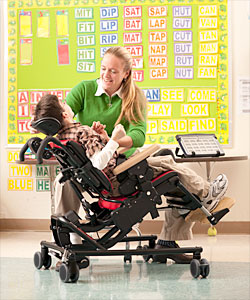To understand why dynamic seating is important we first need to understand what it is. The word “dynamic” is used to describe the presence of movement, as opposed to “static” – the absence of movement. Dynamic seating provides the support needed to remain safely positioned yet have the ability to move in all planes necessary to accomplish activities of daily living, which, as we know, can range from performing fine motor skills at a table to washing hands at a sink to swallowing during feeding treatment. Dynamic seating is also indicated for managing pressure or accommodating voluntary or involuntary movements. It is designed to accommodate dynamic movement which can be any direction: horizontal, anterior or posterior, and even rotational. Individuals with neuromuscular or sensory processing challenges can benefit from this type of seating. Even the most sedentary individuals – those with fixed deformities or minimal visible movements – need the pelvic stabilization provided by dynamic seating; although not visually apparent, there is still subtle dynamic movement in their posture and supportive surface tissues.
Pelvic Stabilization Supports Dynamic Movement
When talking about dynamic seating, it is important to remember that dynamics – movement – can occur in the user, in the seat, or in the chair base. Generally, as seating clinicians we like to see dynamic movement overall, but there are times and situations where static (or stable) positioning is necessary. Take, for instance, the pelvis. Good seating starts with pelvic stability.
Only with a stabilized pelvis can a user engage in dynamic or functional activities. For this reason placement of pelvic belt is critical.

A pelvic belt/support should be positioned to allow for hip flexion as the user moves in the forward plane for functional movement. When the belt is too loose or mounted and angled too high, the user “submarines” under the belt. This can cause soft tissue trauma especially in sudden movement. The belt should fit snugly and be mounted appropriately to allow hip flexion. (Important transportation note: postural support belts attached to the wheelchair are generally not strong enough to withstand the forces of a crash and are usually not positioned correctly to restrain the occupant safely in a crash.)
I have found the Hip Grip by Bodypoint to be a great pelvic positioning aid. It can be attached to a base of a classroom chair, therapy bench or wheelchair. This unique product not only provides pelvic control and stability but it allows anterior/posterior pelvic tilt ROM and improves functional reach.
Dynamic Seating Positions
 Movement or dynamics in the chair seat can be achieved in both the supportive back and the seat cushion. The cushion provides dynamic support through the filler material, including fluid or air. Mechanical alternating pressure management cushions provide dynamic movement in all areas of the seat. Secondary supports also play a role in positioning for dynamic movement. Head rests, chest straps and ankle huggers can all allow dynamic movement as well as support in preferred resting positions.
Movement or dynamics in the chair seat can be achieved in both the supportive back and the seat cushion. The cushion provides dynamic support through the filler material, including fluid or air. Mechanical alternating pressure management cushions provide dynamic movement in all areas of the seat. Secondary supports also play a role in positioning for dynamic movement. Head rests, chest straps and ankle huggers can all allow dynamic movement as well as support in preferred resting positions.
Finally, the base of a chair can accommodate dynamics by forward tilt, recline, lateral tilt, and elevation. Back canes can also be designed to absorb much of the user’s motion. Entire wheelchair frames flex with the user in extreme movements. Both manual and power wheelchair bases combined with an activity chair can be tilted, reclined, preclined or elevated either manually or in a powered mode.
For people with disabilities, dynamic seating is huge. It creates an environment in which the individual feels comfortable and supported enough to achieve functional activities. As professionals and as advocates for the patients under our care, this is always our goal.
Back to Top